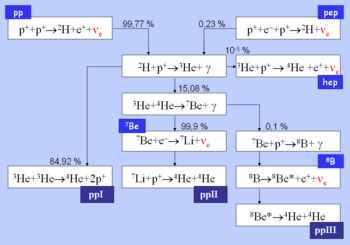
Solar neutrino
Encyclopedia

Electron neutrino
The electron neutrino is a subatomic lepton elementary particle which has no net electric charge. Together with the electron it forms the first generation of leptons, hence its name electron neutrino...
s are produced in the Sun
Sun
The Sun is the star at the center of the Solar System. It is almost perfectly spherical and consists of hot plasma interwoven with magnetic fields...
as a product of nuclear fusion
Nuclear fusion
Nuclear fusion is the process by which two or more atomic nuclei join together, or "fuse", to form a single heavier nucleus. This is usually accompanied by the release or absorption of large quantities of energy...
. By far the largest fraction of neutrinos passing through the Earth are Solar neutrinos.
The main contribution comes from the so-called proton-proton chain reaction
Proton-proton chain reaction
The proton–proton chain reaction is one of several fusion reactions by which stars convert hydrogen to helium, the primary alternative being the CNO cycle. The proton–proton chain dominates in stars the size of the Sun or smaller....
. The net reaction is:
-
 ,
,
or in words:
- 4 protons + 2 electrons = HeliumHeliumHelium is the chemical element with atomic number 2 and an atomic weight of 4.002602, which is represented by the symbol He. It is a colorless, odorless, tasteless, non-toxic, inert, monatomic gas that heads the noble gas group in the periodic table...
+ 2 electron neutrinoElectron neutrinoThe electron neutrino is a subatomic lepton elementary particle which has no net electric charge. Together with the electron it forms the first generation of leptons, hence its name electron neutrino...
s.
The highest flux of solar neutrinos come directly from the proton-proton interaction, and have a low energy, up to 400 keV. There are also several other significant production mechanisms, with energies up to 18 MeV.
The number of neutrinos can be predicted by the Standard Solar Model
Standard Solar Model
The Standard Solar Model refers to a mathematical treatment of the Sun as a spherical ball of gas...
. The detected number of electron neutrinos was only 1/3 of the predicted number, and this was known as the solar neutrino problem
Solar neutrino problem
The solar neutrino problem was a major discrepancy between measurements of the numbers of neutrinos flowing through the Earth and theoretical models of the solar interior, lasting from the mid-1960s to about 2002...
. It led to the idea of neutrino oscillation
Neutrino oscillation
Neutrino oscillation is a quantum mechanical phenomenon predicted by Bruno Pontecorvowhereby a neutrino created with a specific lepton flavor can later be measured to have a different flavor. The probability of measuring a particular flavor for a neutrino varies periodically as it propagates...
and the fact that neutrinos can change flavour. This was confirmed when the total flux of solar neutrinos of all types was measured and it agreed with the earlier predictions of expected electron neutrino flux, as seen by Sudbury Neutrino Observatory
Sudbury Neutrino Observatory
The Sudbury Neutrino Observatory is a neutrino observatory located 6,800 feet underground in Vale Inco's Creighton Mine in Sudbury, Ontario, Canada. The detector was designed to detect solar neutrinos through their interactions with a large tank of heavy water. The detector turned on in May 1999,...
, and thus confirmed that neutrinos have mass.
The energy spectrum of solar neutrinos is also predicted by solar models. It is essential to know this energy spectrum because different neutrino detection experiments are sensitive to different neutrino energy ranges. The Homestake Experiment
Homestake Experiment
The Homestake experiment was an experiment headed by astrophysicists Raymond Davis, Jr. and John N. Bahcall in the late 1960s. Its purpose was to collect and count neutrinos emitted by nuclear fusion taking place in the Sun. Bahcall did the theoretical calculations and Davis designed the experiment...
used chlorine and was most sensitive to solar neutrinos produced by the decay of the beryllium isotope
Isotopes of beryllium
Although beryllium has 12 known isotopes, only one of these isotopes is stable and a primordial nuclide. As such, it is considered a monoisotopic element. It is also a mononuclidic element, because its other isotopes are short-lived that none are primordial and their abundance is very low...
7Be. The Sudbury Neutrino Observatory
Sudbury Neutrino Observatory
The Sudbury Neutrino Observatory is a neutrino observatory located 6,800 feet underground in Vale Inco's Creighton Mine in Sudbury, Ontario, Canada. The detector was designed to detect solar neutrinos through their interactions with a large tank of heavy water. The detector turned on in May 1999,...
is most sensitive to solar neutrinos produced by 8B. The detectors that use gallium
Gallium
Gallium is a chemical element that has the symbol Ga and atomic number 31. Elemental gallium does not occur in nature, but as the gallium salt in trace amounts in bauxite and zinc ores. A soft silvery metallic poor metal, elemental gallium is a brittle solid at low temperatures. As it liquefies...
are most sensitive to the solar neutrinos produced by the proton-proton chain reaction process.
Neutrinos can trigger nuclear reactions. By looking at ancient ores of various ages that have been exposed to solar neutrinos over geologic time, it may be possible to interrogate the luminosity of the Sun over time, which, according to the Standard Solar Model
Standard Solar Model
The Standard Solar Model refers to a mathematical treatment of the Sun as a spherical ball of gas...
, has changed with time.

